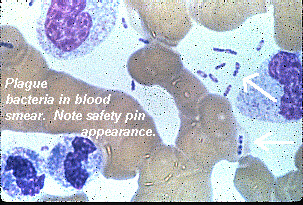Bubonic plague pathophysiology
Yersinia Pestis is the bacteria that causes the bubonic plague , or black death. Typically during the incubation period of the disease, buboes form under the armpits and in the groin area. These buboes are located where the lymph nodes are because that is the location that the bacteria congregates during infection. If untreated, the plague will spread rapidly and cause infection of many other organs.
Classification
Yersinia was formerly classified in the family Pasteurellaceae, but based on DNA- DNA hybridization similarities to ''Escherichia coli'', the Yersinia group has been reclassified as members of the Enterobacteriaceae family (Farmer, 1995). Differentiation of the Enterobacteriaceae family members is based on biochemical and antigenic profiles. More recently, nucleic acid techniques have been applied to assist the definition of genera and species within this family; hence, as more techniques are applied, newly defined genetic relationships sometimes lead to changes in classification. Though there are 11 named species in the genus Yersinia, only 3 are considered important human pathogens: Y. pestis, the etiologic agent of plague, and the enteropathogenic strains, Y. pseudotuberculosis and Y. enterocolitica. Y. pseudotuberculosis is the closest genetic relative to Y. pestis but can be distinguished from the plague bacteria by its clinical manifestations and by laboratory test results. Both Y. pestis and Y. pseudotuberculosis do not frequently infect humans in contrast to Y. enterocolitica, which may be more commonly found in clinical specimens.
Pathogenesis
A very small number of the Yersinia Pestis organisms are needed to infect a mammal. As little as 1 to 10 organisms would be enough to infect a small mammal, such as a rodent or primate, with the plague via subcutaneous, oral, intravenous, and intradermal routes. [1] On the other hand, the respiratory route will take approximately 100 to 200,000 organisms for nonhuman primates.[1] When the bacteria enters the host, there are a multitude of environmental signals that are believed to induce the synthesis and many other factors the contribute to the virulence of the bacteria. These environmental signals include things such as:
- Elevated temperature
- Location within cells at low pH
- Contact with Eukaryotic cells[1]
During the incubation phase, the common symptom of bubonic plague, the bubo, is because the bacilli most commonly spreads to regional lymph nodes. The infection will rapidly progress if it is left untreated and then septicemia will develop and the infection will spread to other organs. Cyanosis and necrosis are commonly seen in septicemic plague, which may be caused by coagulase activity of the plasminogen activator. There are a few tissues that are most commonly infected. They include[1]:
Images
References
- ↑ 1.0 1.1 1.2 1.3 "www.au.af.mil" (PDF). Retrieved 2012-03-06.

